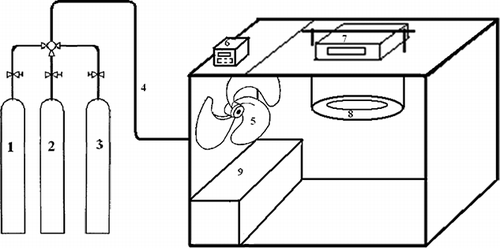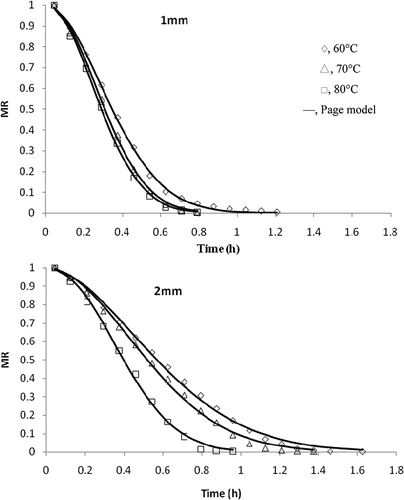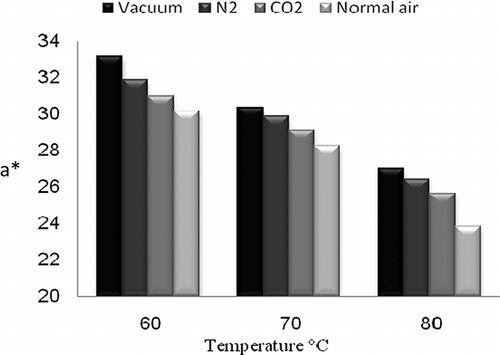Abstract
In this study, tomato pulp was dried under modified atmosphere (nitrogen and carbon dioxide) and the effect of drying conditions on color, soluble solid content, and drying rate were investigated. The modified atmosphere was achieved by flushing gases through a laboratory tray dryer. Comparisons were made between modified atmosphere, air, and vacuum-dried samples. The increase in the dryer temperature, in the range 60–80°C, markedly increased the tomato pulp's drying rate. The redness of dried tomato pulp in terms of a* increased in the order of vacuum drying, nitrogen drying, carbon dioxide drying, and air drying. Values of soluble solids content for modified atmospheres were two times greater than that of air atmosphere. The variations of moisture content with time were used to test six different one-layer drying models given in the literature. Among these models, the Page and modified Page models were found to be the best to describe the drying behavior of tomato pulp. The effective diffusivity during the falling-rate period of drying was estimated by using the simplified Fick's second law of diffusion. It was found that the diffusion coefficient depended on dryer temperature.
INTRODUCTION
Tomatoes and tomato products are considered to be a healthy food for various reasons: they are low in fat and calories; free of cholesterol; and they are a good source of fiber, vitamins, and proteins. Tomato quality and its processed products are evaluated according to their redness, which is due to their lycopene content. Therefore, tomato and its products are the main source of lycopene, which makes them important contributors of carotenoids to the human diet.Citation[1, Citation2] Lycopene functions as an anti-oxidant and helps in lowering DNA damage.Citation[3] It is found to be protective in certain cancers, such as prostate cancer, breast cancer, digestive tract cancer, and lung cancer. Because of its lipid solubility, edible oils such as olive oil increase plasma lycopene concentration in the human body.Citation[4, Citation5] In tomato, lycopene absorption is enhanced by heating and processing because these processes will break down the plant cell walls of tomato and allow for the release of lycopene.Citation[6, Citation7]
Drying can be applied to turn the tomato pulp into dried pulp that has a longer shelf life and is readily available; in addition, the cost of packaging, storage, and transportation for dried products is lower than that of raw or canned products. Dried tomato products are usually used as components for pizza and various vegetables and spicy dishes.Citation[3, Citation8] The most popular method used to dry tomato is convective hot air drying. However, this method has some important disadvantages related to physical and structural changes, such as loss of volatiles and aroma and migration of soluble solids to the surface of a sample and build-up of such soluble materials at the surface as the water evaporates.Citation[9, Citation10] Freeze drying, air drying at low temperature, and vacuum drying are other drying methods that can minimize these effects.Citation[11]
Athanasia and KonstantinosCitation[12] determined the retention of lycopene during spray drying of tomato pulp and studied the effect of drying conditions on the lycopene content of tomato powder. Marfil et al.Citation[13] investigated the effects of drying temperatures on ascorbic acid degradation kinetics in caustic-peeled whole tomatoes (with or without osmotic pre-treatment) and in halved and drained tomatoes. Other research works on tomato drying under air conditions have been done by many researchers and the impact of color, lycopene degradation and isomerization, oxidative heat damage, and effect of temperature and/or pressure on pectin esterase activity on dried tomato were investigated.Citation14–19 Citation Citation Citation Citation Citation19]
The effect of tomato drying process under atmospheric conditions on dried tomato properties has already been studied by many researchers.Citation20–23 Citation Citation Citation23] Hawlader et al. Citation[20, Citation21] found improvement in color, rehydration ability, and vitamin C retention in guava and papaya dried samples in a modified atmosphere. O'Neill et al.Citation[22] reported that dried apple cubes in a modified atmosphere were more porous in comparison to air-dried samples. They also showed that the temperature and oxygen levels in the drying atmosphere were important factors in achieving the best quality in terms of color. The results showed that drying of fruits under modified atmosphere conditions may lead to the best quality.
In this article, the color (redness) and soluble solids content in produced dried tomato under different modified atmosphere conditions as well as vacuum drying processes were also conducted in order to make a comparison with air drying atmospheres. The kinetics of tomato pulp dying under modified atmospheres vacuum and air conditions were also investigated. The thin layer drying characteristics of tomato pulp were investigated under different operational conditions, and the experimental data were fit into the mathematical models given in the literature.
MATERIALS AND METHODS
Preparation of Tomato Pulp
Raw fresh tomatoes were purchased from the local market in Tehran. Ripe, sound, and well-colored tomatoes were selected. The tomato pulp used in this study was obtained from the residue of tomatoes that remained in the juicer, and the juice was transferred to another operation unit for clarification.Citation[24] Tomato pulp was stored in a freezer at –20°C until the time of drying experiments. After 2 h of stabilization at ambient temperature, the tomato pulp was passed through a finisher (1-mm screen) to remove seeds and skins, in order to obtain a homogenous tomato pulp. Then about 20 or 40 g, which makes two thicknesses of tomato pulp (1 and 2 mm), was placed onto a stainless steel tray (d = 15.7 cm) and then put into the dryer (length = 70 cm, width = 30 cm, and depth = 40 cm).
Drying Experiments
A laboratory scale tray dryer, shown in , was used in the drying experiments. The dryer essentially consists of a number of units and accessories to control and carry out the drying operation: a fan, a control unit for setting the temperature of the gas (Autonics TZN4S), gas heater, drying chamber, and a weighing system. The tray was carried on a support frame that was connected to a digital balance, placed above the drying chamber. The weight loss of tomato pulp was continuously monitored by the balance, until the difference between the two recent recordings was smaller than 0.1 g. The mean gas velocity was measured using an anemometer (model 360, CHY Firemate Co., Taiwan). The gases, supplied by compressed air, CO2, or N2 cylinder was heated to the operating temperature in a 750 W electrical heater, which was placed inside the gas heating duct. Drying experiments were carried out at 60, 70, and 80°C gas temperature, and at a constant gas flow velocity of 0.6 ms−1, the gas flow was parallel to the product. Before each experiment, the drying chamber was flushed with the gas for about 10 min until it reached the desired level of gas concentration. The modified gas concentration in the drying chamber was detected by a Sensor Data gas analyzer. The average concentration of inert gas in the drying chamber was 95.8% (V/V). Vacuum drying was achieved by using an EHRET-Vacuum drying cabinet (type VTS 70, EHRET GmbH, Freiburg, Germany), and the drying was performed at a pressure of 20 kPa and at 60, 70, and 80°C.
Mathematical Modeling of Drying Curves
Drying behavior can be predicted and simulated by mathematical modeling, and this procedure would lead to a better understanding of the drying mechanism.Citation[25] The experimental drying data were processed to find the most convenient model among six different drying models given in . The dimensionless moisture ratio is expressed as (M – Me )/(M 0 – Me ), where M is moisture content at any time, kg [H2O] kg−1 [dry matter]; Me is equilibrium moisture content; and M 0 is initial moisture content. Regression was undertaken using a Quasi-Newton numerical method. In addition to the coefficient of determination R 2, reduced chi-square χ2 and mean bias error (MBE) were used to evaluate the fit quality of these models.
Table 1 Mathematical models given by various authors for drying curves.Citation24–26 Citation Citation26]
Color Measurements
CIE (Commission International de l'Eclairage) color values of dried tomato pulp were measured using a spectrophotometer (Color-Eye 7000A, X-Rite, Victoria, Australia). For each experiment, the dried sample was pressed into a tablet by using hydraulic press apparatus in order to capture the lightness (L*), redness (a*), and yellowness (b*), and the mean of three readings were recorded.
Soluble Solids Content
A high accuracy ABBE refractometer (2WAJ model, SinoScience & Technology Co., Zangzhou, Fujian, China) was used to measure the soluble solids content of the solution prepared by mixing 0.15 g ground dry pulp with 10 ml distilled water at 30°C, which is achieved by connecting the device with a circulating thermostatic bath. The mean value of the three readings was reported.
Statistical Analysis
Color and soluble solid measurements were made in triplicate for each batch. Analysis of variance (ANOVA) and Duncan's test was used to determine the significance among the mean values of color and soluble solid content of dried tomato pulp. The SPSS (version 14, IBM Corp., Armonk, NY, USA) windows program was used in order to analyze the experimental data.
RESULTS AND DISCUSSION
Drying Curves
The initial moisture content of the tomato pulp was about 14.38 kg [H2O] kg−1 [dry matter], and the final moisture of the dried pulp was about 0.11 kg [H2O] kg−1 [dry matter]. The variations in the moisture content as a function of time at various temperatures, different atmospheres (air, N2, CO2, and vacuum), and at different thicknesses is presented in and , respectively. As expected, the drying time decreased markedly with an increase in the atmosphere temperature. The time needed to reach the final moisture content was nearly the same for air, N2, and CO2, which is due to their close ρCp values (N2: 1.01 kJ/m3.°C; air: 1.00 kJ/m3.°C; and CO2: 1.3 kJ/m3.°C); in addition to that, the gas velocity, which is the most essential parameter that affects the rate of drying, was the same in all three atmospheres.
Figure 2 Effect of atmosphere temperature on the moisture content of tomato pulp at various atmospheres and thicknesses.
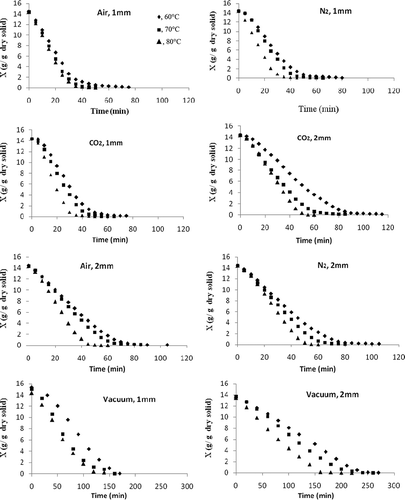
Figure 3 Effect of atmosphere on the moisture content of tomato pulp at various thicknesses. (Color figure available online.)
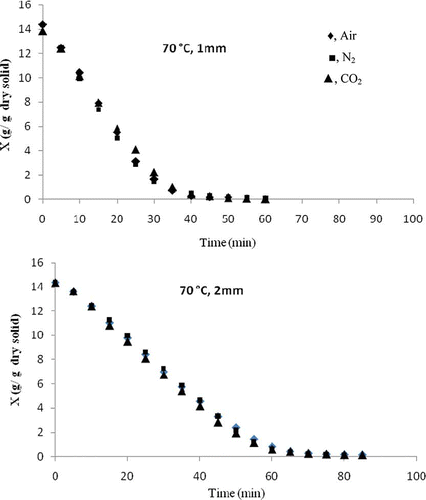
It was found that, at a certain thickness and temperature, gas drying has a shorter drying time compared to vacuum drying, which represents the effect of convective heat transfer on increasing the rate of drying. As expected, at a certain atmosphere temperature, drying time increases with increasing the thickness of tomato pulp in the tray. Increasing the feed thickness decreases the mass transfer coefficients.
Calculation of Effective Diffusivity and Activation Energy
Diffusion-controlled mass transfer is assumed when the vapor or liquid flow conforms to Fick's second law of diffusion.Citation[26] Assuming the sample as slab of thickness H drying on one side and under the given boundary conditions of
The following equation is derived for slab geometry and can be used to find the effective diffusivity:
where MR is the dimensionless moisture ratio; H is the thickness of the sample in m; and Deff is the effective diffusivity in m2 s−1. The slope of the plot drawn for experimental drying data in terms of LnMR against drying time gives the effective diffusivity.Citation[27, Citation28]
The values of effective diffusivity for all atmospheres are presented in . At 2 mm thickness there are two falling rate periods; therefore, two effective diffusivity values were calculated for these thicknesses. It can be seen that the gas temperature and the thickness of the sample influenced the effective diffusivity. As the gas temperature increases, the effective diffusivity increases as well and it decreases with the increase in feed thickness. There were no significant changes between the effective diffusivity values of different gases.
Table 2 Diffusivity of tomato pulp in different atmospheres
Modeling of Drying Curve
The results of nonlinear regression of fitting the six drying models to the experimental data and statistical computations used to assess the consistency of models are presented in . The Page and modified Page models give the highest value of R 2 and the lowest value of χ2 and MBE. Thus, these models may be assumed to represent the drying behavior of tomato pulp. shows that the experimental moisture ratio fit the Page model, which indicates a good fit.
Table 3 Results of statistical analyses on the modeling of moisture content and drying time for CO2 atmosphere at thickness of 1 mm
Color Measurements
The results of color measurements in term of a* and hue values for dried tomato are shown in and , respectively. It was found that temperature and type of atmosphere have a significant effect on the color of dried samples. The hue values have a different trend comparison of the +a* values as a function of temperature, when temperature decreased, the +a* values increased and hue value reduced. Increasing +a* values as well as decreasing hue value mean better redness color of dried tomato. During tomato drying, the oxidation and isomerization of lycopene can occur and the redness color of dried tomato reduced.Citation[14] The non-enzymatic browning or Maillard reaction can also happen during tomato drying and an intermediate product that is known as HMF (5-hydroxymethyl-2-furfural), which can increase the hue value and decrease red color, may be formed.Citation[29, Citation30] Drying at higher temperature caused a higher formation of HMF, which changed the typical red color to brick-red. Reduction of oxygen content in the drying chamber could improve the color. The air oxygen content is approximately 20% in volume, while that of modified atmosphere is much lower. The +a* values increased by changing atmosphere in order of air, CO2, N2, and vacuum, which is the result of less oxidative damages of lycopene as well as non-enzymatic browning reaction.
As a result, the desired color of dried tomato pulp was better at lower temperatures and inert atmosphere. The statistical analysis showed that the results of a* values at various temperatures and atmospheres were significantly different (p ≤ 0.05), although, the variation of temperature had more effect on the redness of dried samples (F = 38997), in comparison with the effect of changing atmosphere (F = 4723). The F value for temperature and atmosphere interaction, which was 132, indicated that their interaction effect on red color was not significant.
Soluble Solids Content
Usually thermal processes change the structure and physical properties of products, especially for vegetables that consist of water, vitamins, amino acid, and carbohydrate. Migration and degradation of tomato soluble solids, such as ascorbic acid and amino acids, is an undesirable change that affects the final product quality. Also, the proteins and carbohydrate can be changed by thermal and oxidation damages in drying processes. The soluble solids content of the solution of dried pulp resulted from four drying atmospheres compared in . It can be seen that the soluble solid content of inert atmosphere dried pulp is approximately two times greater than that of air-dried pulp. The low temperature improves solid content, which is acceptable. On the other hand, the modified atmosphere had more effect on soluble solids content that is due to low oxygen content in the drying process.
Table 4 Soluble solid content of dried tomato solution
According to Duncan's test, there were significant differences in soluble solids content between drying temperatures of 60, 70, and 80°C, whereas air drying led to a significant difference from all the modified atmospheres used for drying of tomato pulp. F values indicated that the effect of atmosphere on soluble solid content is stronger than temperature (F atmosphere = 549 and F temperature = 131).
CONCLUSIONS
The following results may be achieved from the present work in which drying of tomato pulp under different conditions has been studied. It was found that the drying rate markedly increased as atmosphere temperature increased. More time is required for thicker samples to reach the equilibrium moisture content. Modified atmosphere drying improved the color and soluble solid content of dried tomato pulp to a level that was comparable with the results of vacuum drying; also, the rate of modified atmosphere drying is so much higher than vacuum drying. According to the results of nonlinear regression of six drying models, the Page drying model best described the drying behavior of tomato pulp at different drying conditions. Further, the diffusion coefficients are the most essential factors in the moisture transfer, and were dependent on the drying temperature.
NOMENCLATURE
| a* | = |
Redness |
| b* | = |
Yellowness |
| Deff | = |
Effective diffusivity (m2 s−1) |
| H | = |
Thickness of the sample (m) |
| L* | = |
Lightness |
| χ2 | = |
Reduced chi-square |
| M | = |
Moisture content at any time (kg [H2O] kg−1 [dry matter]) |
| MBE | = |
Mean bias error |
| MR | = |
Dimensionless moisture ratio |
| R 2 | = |
Coefficient of determination |
| t | = |
Time (s) |
| X | = |
Moisture content (−) |
| MR | = |
Moisture ratio |
Subscripts
| Pre | = |
Predicted |
| Exp | = |
Experimental |
| e | = |
Equilibrium |
REFERENCES
- Hossain , M.A. and Gottschalk , K. 2009 . Single layer drying characteristics of half fruit tomato . International Journal of Food Properties , 12 ( 4 ) : 871 – 884 .
- Hui , Y.H. , Chandan , R.C. , Clark , S. and Cross , N.A. 2007 . “ Tomato processing ” . In Handbook of Food Products Manufacturing , 1091 – 1096 . Hoboken, New Jersey : John Wiley & Sons, Inc .
- Sacilik , K. 2007 . The thin-layer modeling of tomato drying process . Agriculturae Conspectus Scientificus , 72 ( 4 ) : 343 – 349 .
- Fielding , J.M. , Rowley , K.G. , Cooper , P. and O'dea , K. 2005 . Increases in plasma lycopene concentration after consumption of tomatoes cooked with olive oil . Asia Pacific Journal of Clinical Nutrition , 14 ( 2 ) : 131 – 136 .
- Luengwilai , K. , Fiehn , O.E. and Beckles , D.M. 2010 . Comparison of leaf and fruit metabolism in two tomato (Solanum lycopersicum L.) genotypes varying in total soluble solids . Journal of Agricultural and Food Chemistry , 58 ( 22 ) : 11790 – 11800 .
- Quek , S.Y. , Chok , N.K. and Swedlund , P. 2007 . The physicochemical properties of spray-dried watermelon powders . Chemical Engineering and Processing , 46 : 386 – 392 .
- Tsamo , C.V.P. , Bilame , A.-F. and Ndjouenkeu , R. 2006 . Air drying behaviour of fresh and osmotically dehydrated onion slices (allium cepa) and tomato fruits (lycopersicon esculentum) . International Journal of Food Properties , 9 ( 4 ) : 877 – 888 .
- Giovanelli , G. and Paradiso , A. 2002 . Stability of dried and intermediate moisture tomato pulp during storage . Journal of Agricultural and Food Chemistry , 50 ( 25 ) : 7277 – 7281 .
- Srikiatden , J. and Roberts , J.S. 2005 . Moisture loss kinetics of apple during convective hot air and isothermal drying . International Journal of Food Properties , 8 ( 3 ) : 493 – 512 .
- Jongaroontaprangsee , S. , Tritrong , W. , Chokanaporn , W. , Methacanon , P. , Devahastin , S. and Chiewchan , N. 2007 . Effects of drying temperature and particle size on hydration properties of dietary fiber powder from lime and cabbage by-products . International Journal of Food Properties , 10 ( 4 ) : 887 – 897 .
- Akanbi , C.T. , Adeyemi , R.S. and Ojo , A. 2005 . Drying characteristics and sorption isotherms of tomato slices . Journal of Food Engineering , 73 : 157 – 163 .
- Athanasia , M.G. and Konstantinos , G.A. 2004 . Stability of lycopene during spray drying of tomato pulp . LWT–Food Science and Technology , 38 : 479 – 487 .
- Marfil , P.H.M. , Santos , E.M. and Telis , V.R.N. 2008 . Ascorbic acid degradation kinetics in tomatoes at different drying conditions . LWT–Food Science and Technology , 41 : 1642 – 1647 .
- Shi , J. , Le Maguer , M. , Kakuda , Y. , Lipaty , A. and Neikamp , F. 1999 . Lycopene degradation and isomerization in tomato dehydration . Food Research International , 32 : 15 – 21 .
- Karatas , S. and Esin , A. 1994 . Determination of moisture diffusivity and behavior of tomato concentrate droplets during drying in air . Drying Technology , 12 ( 4 ) : 799 – 822 .
- Telis , V.R.N. and Sorpbal , P.J.A. 2002 . Glass transitions for freeze-dried and air-dried tomato . Food Research International , 35 : 435 – 443 .
- Zanoni , B. , Peri , C. , Nani , R. and Lavelli , V. 1999 . Oxidative heat damage of tomato halves as affected by drying . Food Research International , 31 ( 5 ) : 395 – 401 .
- Van den Broeck , I. , Ludikhuyze , L.R. , Van Loey , A.M. and Hendrickx , M.E. 2000 . Effect of temperature and/or pressure on tomato pectinesterase activity . Journal of Agricultural and Food Chemistry , 48 ( 2 ) : 551 – 558 .
- Lavelli , V. , Hippeli , S. , Dornisch , K. , Peri , C. and Elstner , E.F. 2001 . Properties of tomato powders as additives for food fortification and stabilization . Journal of Agricultural and Food Chemistry , 49 ( 4 ) : 2037 – 2042 .
- Hawlader , M.N.A. , Perera , C.O. and Tian , M. 2006 . Properties of modified atmosphere heat pump dried foods . Journal of Food Engineering , 74 : 392 – 401 .
- Hawlader , M.N.A. , Perera , C.O. , Tian , M. and Yeo , K.L. 2006 . Drying of guava and papaya: Impact of different drying methods . Drying Technology , 24 : 77 – 87 .
- O'Neill , M.B. , Rahman , M.S. , Perera , C.O. , Smith , B. and Melton , L.D. 1998 . Color and density of apple cubes dried in air and modified atmosphere . International Journal of Food Properties , 1 ( 3 ) : 197 – 205 .
- Roberts , J.S. and Tong , C.H. 2003 . Drying kinetics of hygroscopic porous materials under isothermal conditions and the use of a first-order reaction kinetic model for predicting drying . International Journal of Food Properties , 6 ( 3 ) : 355 – 367 .
- Razi , B. , Aroujalian , A. , Raisi , A. and Fathizadeh , M. 2011 . Clarification of tomato juice by cross-flow microfiltration . International Journal of Food Science & Technology , 46 ( 1 ) : 138 – 145 .
- Togrul , I.T. and Pehlivan , D. 2003 . Modeling of drying kinetics of single apricot . Journal of Food Engineering , 58 : 23 – 32 .
- Perry , R. and Green , D.W. 1997 . Perry's Chemical Engineers' Handbook , 7th , Vol. 12 , 33 New York : McGraw-Hill .
- Rahman , M.S. 2003 . A theoretical model to predict the formation of pores in foods during drying . International Journal of Food Properties , 6 ( 1 ) : 61 – 72 .
- Jumah , R. , Banat , F. , Al-Asheh , S. and Hammad , S. 2004 . Drying kinetics of tomato paste . International Journal of Food Properties , 7 ( 2 ) : 253 – 259 .
- Cernisev , S. 2010 . Effects of conventional and multistage drying processing on non-enzymatic browning in tomato . Journal of Food Engineering , 96 : 114 – 118 .
- Shi , J. , Maguer , M. L. , Kakuda , Y. , Liptay , L. and Niekamp , F. 1999 . Lycopene degradation and isomerization in tomato dehydration . Food Research International , 32 : 15 – 21 .

